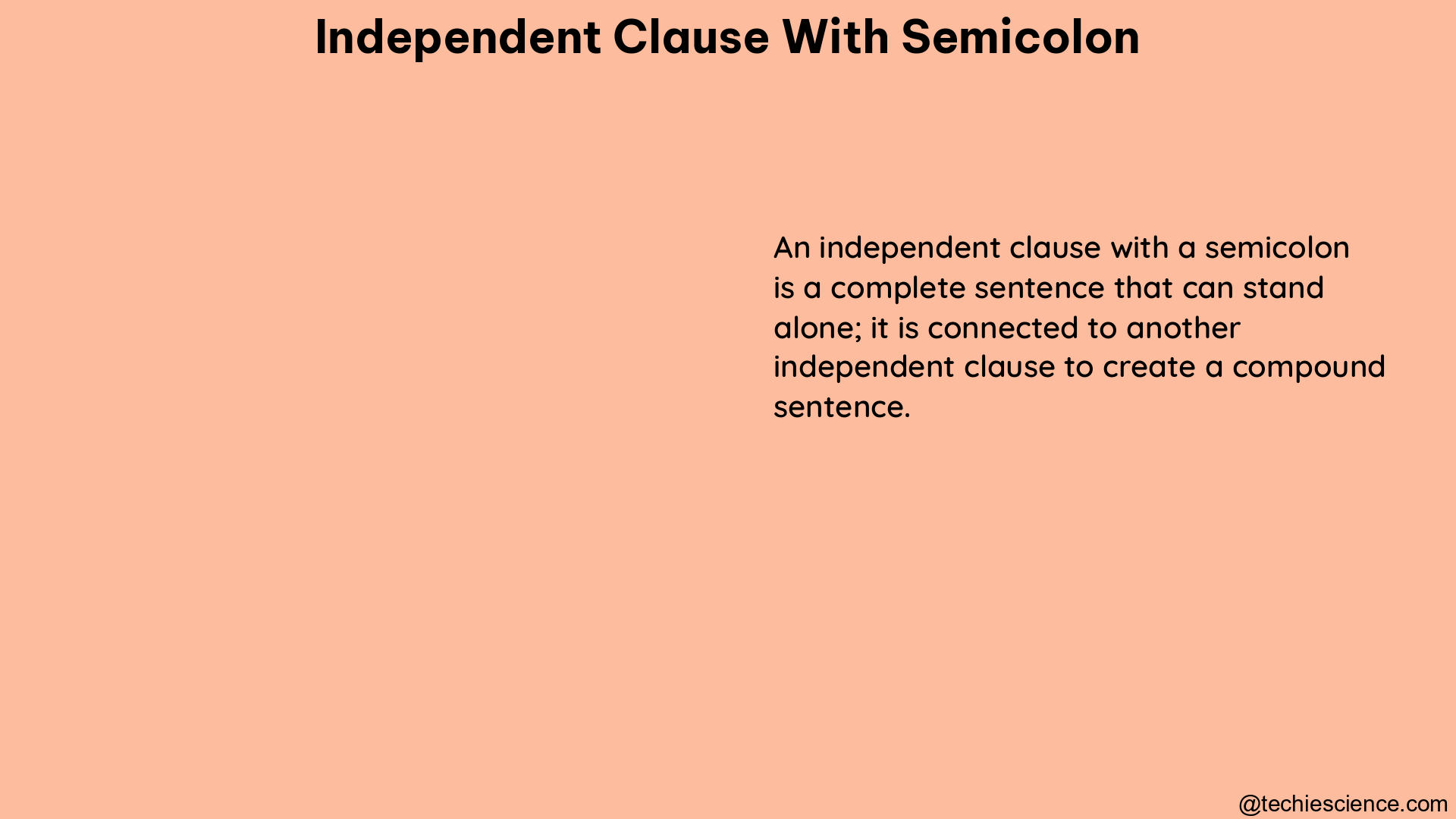An independent clause with a semicolon is a powerful grammatical construction that allows you to join two complete sentences while maintaining a clear relationship between them. Whether you’re a student, a writer, or simply someone who wants to improve their command of the English language, understanding the proper use of semicolons in independent clauses is a crucial skill.
Understanding Independent Clauses
An independent clause is a group of words that contains a subject and a verb and can stand alone as a complete sentence. These clauses are the building blocks of clear and effective communication, and mastering their usage is essential for anyone who wants to write with precision and clarity.
Identifying Independent Clauses
To identify an independent clause, look for the following elements:
- Subject: The noun or pronoun that the clause is about.
- Verb: The action or state of being that the subject is performing or experiencing.
- Complete Thought: The clause must express a complete idea that can stand on its own as a sentence.
Here are some examples of independent clauses:
- The sun is shining brightly.
- She loves to read mystery novels.
- They will be arriving at the airport later today.
Using Semicolons to Connect Independent Clauses

Semicolons are a powerful punctuation tool that can be used to connect two independent clauses that are closely related in meaning. This allows you to create a more complex and nuanced sentence structure without relying on conjunctions like “and,” “but,” or “because.”
Semicolon Rules for Independent Clauses
When using a semicolon to connect independent clauses, there are a few key rules to keep in mind:
-
Closely Related Clauses: The two independent clauses must be closely related in meaning and content. They should be able to stand alone as complete sentences, but they should also be logically and thematically connected.
-
No Coordinating Conjunction: There should be no coordinating conjunction (like “and,” “but,” or “or”) between the two independent clauses.
-
Transitional Expressions: Semicolons can also be used to connect independent clauses that are linked by a transitional expression, such as a conjunctive adverb (e.g., “however,” “therefore,” “consequently”) or a transitional phrase (e.g., “in other words,” “for instance”).
Here are some examples of independent clauses connected with semicolons:
- The weather was beautiful today; I decided to go for a long walk.
- The project is due next week; however, I still have a lot of work to do.
- The new restaurant opened last month; in fact, I’ve already been there twice.
Mastering Semicolon Usage
Using semicolons effectively takes practice, but with a solid understanding of the rules and some examples to guide you, you can become a pro in no time.
Avoiding Common Mistakes
One of the most common mistakes when using semicolons is to connect two clauses that are not truly independent. For example, the following sentence is incorrect:
- I went to the store; because I needed to buy some milk.
In this case, “because I needed to buy some milk” is a dependent clause, not an independent clause. To fix this, you would need to use a comma instead of a semicolon:
- I went to the store because I needed to buy some milk.
Another common mistake is to use a semicolon when a period or a comma would be more appropriate. For example:
- I love cats; they are such wonderful pets.
In this case, a comma would be more appropriate:
- I love cats, they are such wonderful pets.
Practicing with Examples
The best way to master the use of semicolons in independent clauses is to practice with a variety of examples. Here are some additional practice sentences:
- The team won the game; they played their hearts out.
- The new software update is available; it includes several bug fixes.
- The book was fascinating; however, I found the ending a bit disappointing.
- The concert was sold out; in fact, tickets were going for double the original price.
- The car needed a tune-up; consequently, I had to take it to the mechanic.
As you practice, pay close attention to the relationship between the independent clauses and the use of transitional expressions. With time and repetition, the proper use of semicolons in independent clauses will become second nature.
Conclusion
Mastering the use of semicolons in independent clauses is a valuable skill that can elevate your writing and communication skills. By understanding the rules and practicing with a variety of examples, you can learn to use this powerful punctuation tool with confidence and precision.
Remember, the key to using semicolons effectively is to ensure that the independent clauses are closely related in meaning and that there is no coordinating conjunction between them. With this knowledge, you can create more complex and nuanced sentences that convey your ideas with clarity and sophistication.
So, start practicing today and watch your writing skills soar!
References:
- https://www.butte.edu/departments/cas/tipsheets/punctuation/semicolon.html
- https://writing.wisc.edu/handbook/semicolons/
- https://www.grammarflip.com/curriculum/semicolons-between-independent-clauses/
- https://beaconpointservices.org/semicolons-with-independent-clauses/
- https://www.grammarly.com/blog/semicolon/

Hi! I am Bhabesh Sing. I have completed M.A in English, M.A in Vocal Music, and B.Ed. I am a creative writer. Currently, I am a Subject Matter Expert in English on this Platform.
Let’s connect through LinkedIn-https://www.linkedin.com/in/bhabesh-sing-660914ab